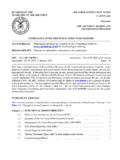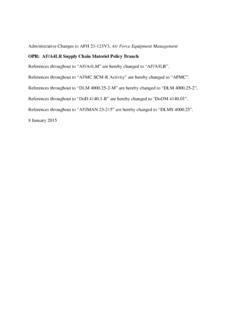Transcription of BY ORDER OF THE AIR FORCE POLICY DIRECTIVE 23-1 …
1 BY ORDER OF THE SECRETARY OF THE AIR FORCE AIR FORCE POLICY DIRECTIVE 23-1 30 SEPTEMBER 2016 Materiel Management SUPPLY CHAIN MATERIEL MANAGEMENT COMPLIANCE WITH THIS PUBLICATION IS MANDATORY ACCESSIBILITY: Publications and forms are available on the e-Publishing website at for downloading or ordering. RELEASABILITY: There are no releasability restrictions on this publication. OPR: SAF/AQD Supersedes: AFPD23-1, 15 February 2011 Certified by: SAF/AQ (Ms Darlene Costello) Pages: 10 This Air FORCE POLICY DIRECTIVE (AFPD) provides direction for Air FORCE (AF) supply chain materiel management through implementation of Department of Defense Instruction (DoDI) , DoD Supply Chain Materiel Management POLICY and designates Headquarters Air FORCE (HAF) functional responsibilities for Air FORCE supply chain materiel management.
2 It facilitates the implementation of Department of Defense DIRECTIVE (DoDD) , Equipping the Reserve Forces and the following DoDIs: , National Guard and Reserve Equipment Report (NGRER); , Readiness-Based Materiel Condition Reporting for Mission-Essential Systems and Equipment; , Customer Wait Time and Time Definite Delivery; , Management of DoD Clothing and Textiles (Class II); , Management, Control and Disposal of Government Property in the Possession of Contractors; , Accountability and Management of DoD-Owned Equipment and Other Accountable Property; , Defense Materiel Readiness Board (DMRB) to provide a framework for materiel management and responsibilities.
3 It complements POLICY provided in AFPD 63-1/20-1, Integrated Life Cycle Management for product support, and AFPD 24-2, Preparation and Movement of Air FORCE Materiel for the packaging and movement of AF materiel. This AFPD applies to all military and civilian AF personnel, including major commands (MAJCOMs), direct reporting units (DRUs), field operating agencies (FOAs), Air FORCE Reserve, Air National Guard, and other individuals or organizations as required by binding agreement or obligation with the Department of the Air FORCE . Any change or waiver must be approved by the Secretary of the Air FORCE (SECAF).
4 Refer recommended changes and questions about this publication to the Office of Primary Responsibility (OPR) using AF Form 847, Recommendation for Change of Publication; route form from the field through the appropriate Functional Chain of Command. Ensure all records created as a result of processes prescribed in this publication are maintained in accordance with 2 AFPD 23-1 30 SEPTEMBER 2016 (IAW) AFMAN 33-363, Management of Records, and disposed of IAW the Air FORCE Records Disposition Schedule (RDS) located in the Air FORCE Records Information Management System (AFRIMS).
5 The following AFPDs correlate with this Publication: AFPD 10-2, Readiness; AFPD 10-3, Air Reserve Component Forces; AFPD 10-4, Operations Planning: Air and Space Expeditionary FORCE (AEF); AFPD 10-6, Capability Requirements Development; AFPD 13-5, Air FORCE Nuclear Enterprise; AFPD 21-2, Munitions; AFPD 25-1, War Reserve Materiel; AFPD 36-26, Total FORCE Development; AFPD 38-1, Organization and Unit Designation; AFPD 90-8, Environment, Safety & Occupational Health Management and Risk Management. SUMMARY OF CHANGES This publication has been substantially revised and needs to be completely reviewed.
6 This rewrite reflects the new Certifying Official responsibility for SAF/AQ, satisfies POLICY gaps that currently exist between DoD POLICY and AF guidance, and clarifies the roles and responsibilities within the HAF for supply chain materiel management. 1. AF Supply Chain Materiel Management. It is AF POLICY to: Use the supply chain operational reference processes of plan, source, make and maintain, deliver, and return as a framework for developing, improving, and conducting materiel management activities to satisfy customer support requirements as efficiently as possible.
7 Consider all life-cycle costs associated with materiel management, including acquiring, distributing, transporting, storing, maintaining, repairing, protecting, and disposing. Identify supply chain strategies from supply chain characteristics and apply the strategy consistently for a given type of item, commodity, class, customer, or supplier. Develop guidance that emphasizes supply chain responsiveness and prudent stewardship in supply chain planning, sourcing, maintenance, delivery, retention and disposition of materiel. Establish support strategies to meet customer materiel requirements for active duty AF, Air Reserve Component, Cooperative Logistics Supply Support Arrangements, DoD Components and participating Federal agencies (when acting in the capacity as the Primary Inventory Control Activity).
8 Manage materiel resources from acquisition through disposition. Establish wholesale and retail stockage objectives for peacetime and war reserve materiel (WRM) readiness requirements. Establish provisioning and replenishment objectives to optimize materiel availability and stewardship of costs, and minimize materiel excess/surplus and negative environmental, safety, and occupational health impacts. Ensure all Controlled Inventory Items to include nuclear weapons related materiel (NWRM), classified, communications security (COMSEC), weapons and other sensitive AFPD 23-1 30 SEPTEMBER 2016 3 assets are accurately received, secured, stored, issued, demilitarized and disposed, accounted for and reported to AF and DoD agencies as required.
9 Ensure materiel in storage is maintained in a ready status that prevents property deterioration and loss. Ensure materiel accumulation does not exceed authorized stock or retention limits. Minimize the volume of materiel disposed as scrap or waste through cost-effective reclamation and reuse of materiel. Maintain visibility of serviceable items transferred to Defense Logistics Agency Disposition Services; when practical reutilize items in lieu of initiating a new procurement. Maintain positive inventory control (PIC) and in-transit visibility (ITV) of assets throughout all nodes of the supply chain.
10 Proactively prevent loss and ensure appropriate demilitarization of assets prior to disposal. Ensure cost-effective recovery from surplus, scrap or residual materiel and maximize the reuse of critical, strategic, and precious metals. Comply with AFPD 90-8, Environment, Safety & Occupational Health Management and Risk Management and associated statutes, Occupational Safety and Health standards, environmental regulations, technical orders and safety data sheets. 2. Roles and Responsibilities. The following responsibilities and authorities are established: In conjunction with AFPD 63-1/20-1 direction, the Assistant Secretary for the Air FORCE (Acquisition) (SAF/AQ) shall: Ensure that AF POLICY guidance: Addresses end-to-end AF supply chain requirements and responsibilities.













